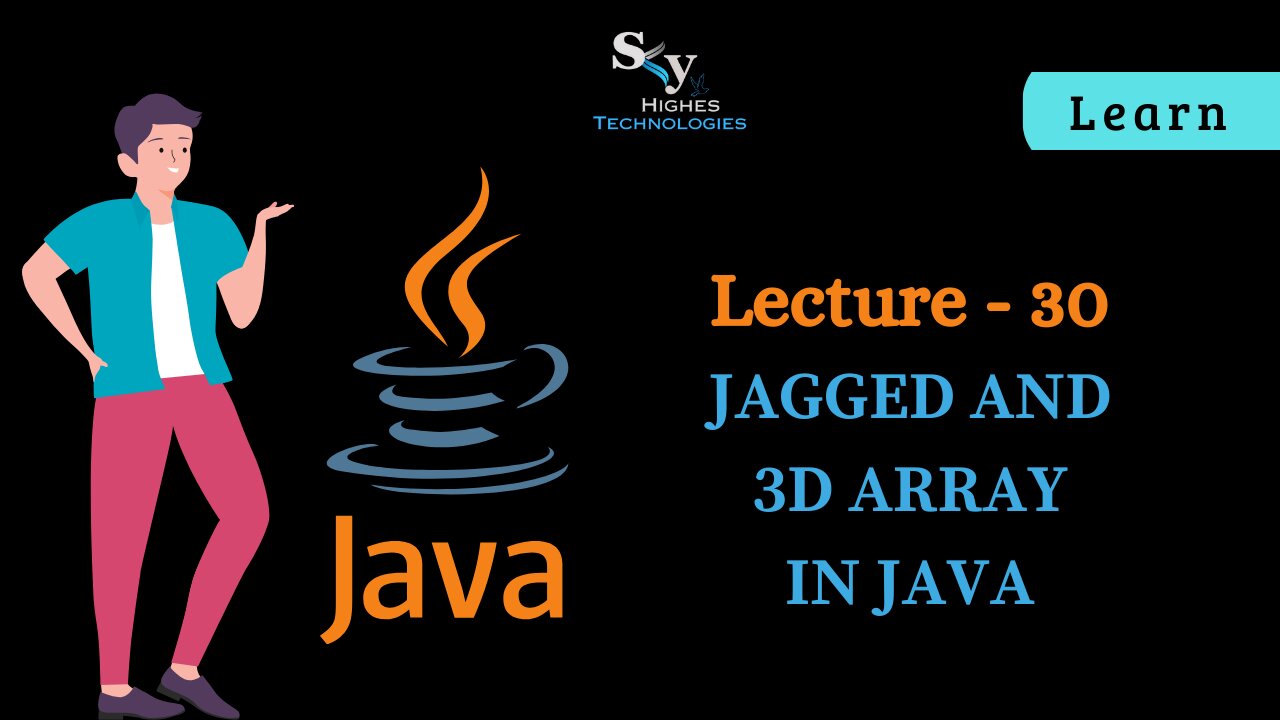Premium Only Content

#30 Jagged and 3D Array in JAVA | Skyhighes | Lecture 30
Here's a comprehensive explanation of jagged and 3D arrays in Java:
Jagged Arrays:
Definition: Arrays of arrays, where each inner array can have a different length.
Visualization: Imagine a staircase with varying step widths.
Creation:
Java
int[][] jagged = new int[3][]; // Declare a 2D array with 3 rows
jagged[0] = new int[5]; // First row has 5 elements
jagged[1] = new int[2]; // Second row has 2 elements
jagged[2] = new int[3]; // Third row has 3 elements
Use code with caution. Learn more
Accessing Elements:
Java
int firstElement = jagged[0][0]; // Access first element in the first row
int lastElement = jagged[2][2]; // Access last element in the third row
Use code with caution. Learn more
Benefits:
Flexible for representing data with varying dimensions.
Efficient memory usage for sparse data (lots of empty values).
3D Arrays:
Definition: Arrays with three dimensions, often used to represent 3D structures or data with three attributes.
Visualization: Think of a Rubik's cube or a block of rooms in a building.
Creation:
Java
int[][][] cube = new int[3][4][2]; // 3 layers, 4 rows, 2 columns
Use code with caution. Learn more
Accessing Elements:
Java
int cornerElement = cube[0][0][0]; // Access corner element
int middleElement = cube[1][2][1]; // Access element in the middle
Use code with caution. Learn more
Benefits:
Model 3D spaces and objects effectively.
Organize complex data with three-level relationships.
Key Differences:
Feature Jagged Array 3D Array
Dimensionality 2D (array of arrays) 3D (array of arrays of arrays)
Row Lengths Can vary Must be the same
Visual Representation Staircase Cube or rectangular block
Common Use Cases Sparse data, varying row structures 3D modeling, data with three attributes
When to Choose:
Jagged Arrays: When you need flexibility in row lengths and want to optimize memory for sparse data.
3D Arrays: When you're working with 3D structures or data with three clear dimensions.
Remember:
Use nested loops to iterate through elements in both jagged and 3D arrays.
Choose the appropriate array type based on your data structure and processing needs.
Visualizing these arrays can help grasp their structure and access patterns.
-
 25:54
25:54
ZeeeMedia
12 hours agoThe Shadow Government, Mask Plague, Nepal Uprising Topples Government | Daily Pulse Ep 104
5.83K23 -
 LIVE
LIVE
Biscotti-B23
5 hours ago🔴 LIVE DRAGON BALL GEKISHIN SQUADRA IS HERE 🐉 RANKED MATCHES & BATTLE PASS SHOWCASE
12 watching -
 27:40
27:40
TheRoyaltyAutoService
14 hours ago $0.05 earnedHow To Replace A Battery Like A Professional!
39 -
 LIVE
LIVE
B2ZGaming
5 hours agoTwo For Tuesday!!! | B2Z Gaming
10 watching -
 LIVE
LIVE
BBQPenguin_
2 hours agoExtraction Action! Looting & PVP
9 watching -
 8:52
8:52
The Art of Improvement
19 hours ago7 Habits Of Unsuccessful People You Don’t Want To Copy
42 -
 36:17
36:17
Uncommon Sense In Current Times
15 hours agoIs Humanism A Religion in Disguise: A Discussion with Humanist Stephen Law - Part 1
8.57K -
 30:07
30:07
Degenerate Plays
14 hours agoReverse Captain America! - Call of Duty: Modern Warfare 2 (2009) : Part 1
22 -
 7:56
7:56
Faith Frontline
12 hours agoCIA Spy CONFIRMS Bible Prophecy Is Playing Out Right Now
59 -
 1:25:26
1:25:26
Coin Stories with Natalie Brunell
20 hours agoCan the State Crush Bitcoin? And the Next Big Financial Crisis with Dave Collum
29.8K1